Children need to eat a variety of foods from all food groups in order to get all the essential nutrients required for growth, development, and the maintenance of health. Continue reading to learn what essential nutrients for children are and how to incorporate them into your child’s diet.

What are essential nutrients for children?
Essential nutrients are naturally occuring chemical substances required by the body to carry out basic functions. The best way to ensure your child gets the nutrients they need is to ensure they eat a well-balanced diet. There are six types of nutrients essential for human health: carbohydrates, fats, proteins, vitamins, minerals, and water. (6)
1. Macronutrients
Macronutrients, which include carbohydrates, fats, and proteins, are nutrients that the body requires in large amounts. These nutrients are required for various bodily functions such as energy production, the growth and maintenance of muscles and tissues, growth and development, and immune function. (6)(20)
2. Carbohydrates
Carbohydrates are the preferred primary source of energy for humans. They are also required for gut health and immune function. (6) Carbohydrates should make up about 50 to 55% of your child’s caloric intake. (3) Healthy sources of carbohydrates include:
- Beans and legumes
- Dairy products
- Fruits, such as apples, bananas, berries, and pineapple
- Vegetables, such as carrots, potatoes, and sweet potatoes
- Whole grains, such as brown rice, whole wheat, and quinoa (8)
Ready to start delivering better patient care?
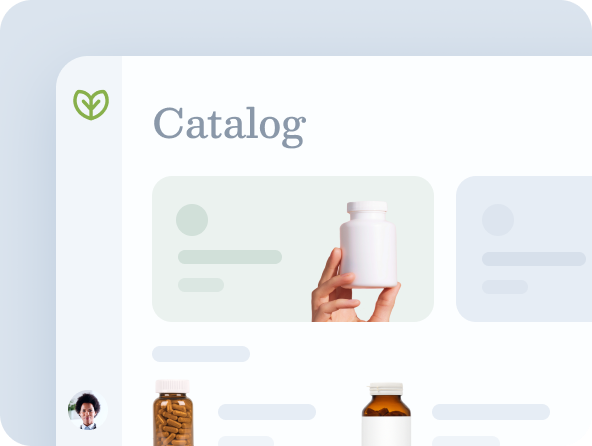
3. Healthy fats
Dietary fats provide the body with the essential fatty acids linoleic and linolenic acid. They are referred to as essential fatty acids as the body cannot synthesize them on its own. Fats play a role in energy production and are required for the absorption of fat-soluble vitamins, such as vitamins A, D, E, and K. Additionally, fats also are required to reduce inflammation and support brain development and blood clotting. (14) Healthy fats should make up about 25 to 30% of your child’s caloric intake. (3) Sources of healthy fats include:
- Avocado and avocado oil
- Eggs
- Dairy
- Nuts and seeds
- Olives and olive oil
- Seafood (8)
4. Proteins
Protein is an essential nutrient as it plays a vital role in cellular structure as well as building and maintaining bones, muscles, and tissues. Protein is made up of amino acids. There are twenty amino acids, nine of which are considered essential. A protein is considered to be complete if it contains at least all nine essential amino acids. (11) Protein should make up about 20% of your child’s caloric intake. (3) Sources of protein include:
- Beans and legumes
- Dairy
- Eggs
- Fish and seafood
- Meat and poultry
- Nuts and seeds
- Soy products, such as tofu and tempeh (8)
5. Micronutrients
Micronutrients are required by the body in small amounts and include vitamins, minerals, and phytochemicals (phytonutrients or various plant nutrients). (5) Vitamins and minerals are necessary for many bodily processes, cell and organ function, and growth and development. (6)(16)
6. Calcium
Calcium is the most abundant mineral in the body. It’s necessary for the growth and maintenance of strong bones and teeth, and it also plays a role in keeping body tissues strong and flexible. Calcium is also required for proper functioning of blood vessels, muscles, blood clotting, nerve transmission, and hormone production. (17) Calcium can be found in foods such as:
- Broccoli
- Chia seeds
- Dairy products, such as cottage cheese, low-fat milk, and yogurt
- Fortified soy milk
- Kale
- Salmon
- Spinach
- Soybeans and tofu
- Turnip greens (17)
The amount of calcium your child needs depends on their age and sex. The table below outlines the Recommended Dietary Allowances (RDAs) for calcium.
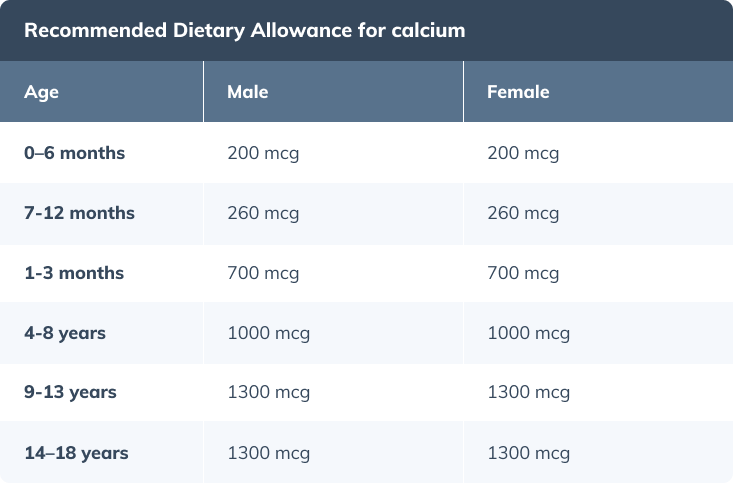
Did you know? RDAs for nutrients tell you the amount of a nutrient you should get each day. RDAs differ based on age, gender. (10)
7. Iron
Iron is an essential mineral for human health. It’s part of hemoglobin, a protein that is present in red blood cells. (12) Hemoglobin is responsible for carrying oxygen to your body’s organs and tissues, bringing carbon dioxide back to your lungs. (13) It’s an important nutrient for children as it plays a role in growth, neurological (brain) development, cellular function, and the production of some hormones. (18) Dietary iron can be found in two forms: heme and nonheme. (23) Plant-based foods and food products fortified with iron contain nonheme iron. Animal sources of iron found in foods such as meat, poultry, and seafood contain heme iron. (2) Heme iron from animal foods is better absorbed by the body than nonheme iron in plant-based foods. (2)(24)
Did you know? The body can absorb heme iron from plant based foods, at a higher rate when it’s combined with acidic foods containing vitamin C, such as broccoli, citrus fruits, peppers, strawberries, and tomatoes. (18)
Foods that contain heme iron include:
- Chicken
- Oysters
- Red meat, such as beef and lamb
- Sardines
Foods that contain nonheme iron include:
- Beans
- Dark chocolate
- Fortified grain products
- Leafy greens, such as spinach
- Legumes, such as chickpeas, lentils, and white beans
- Nuts
- Tofu
- Vegetables, such as broccoli, and peas (19)
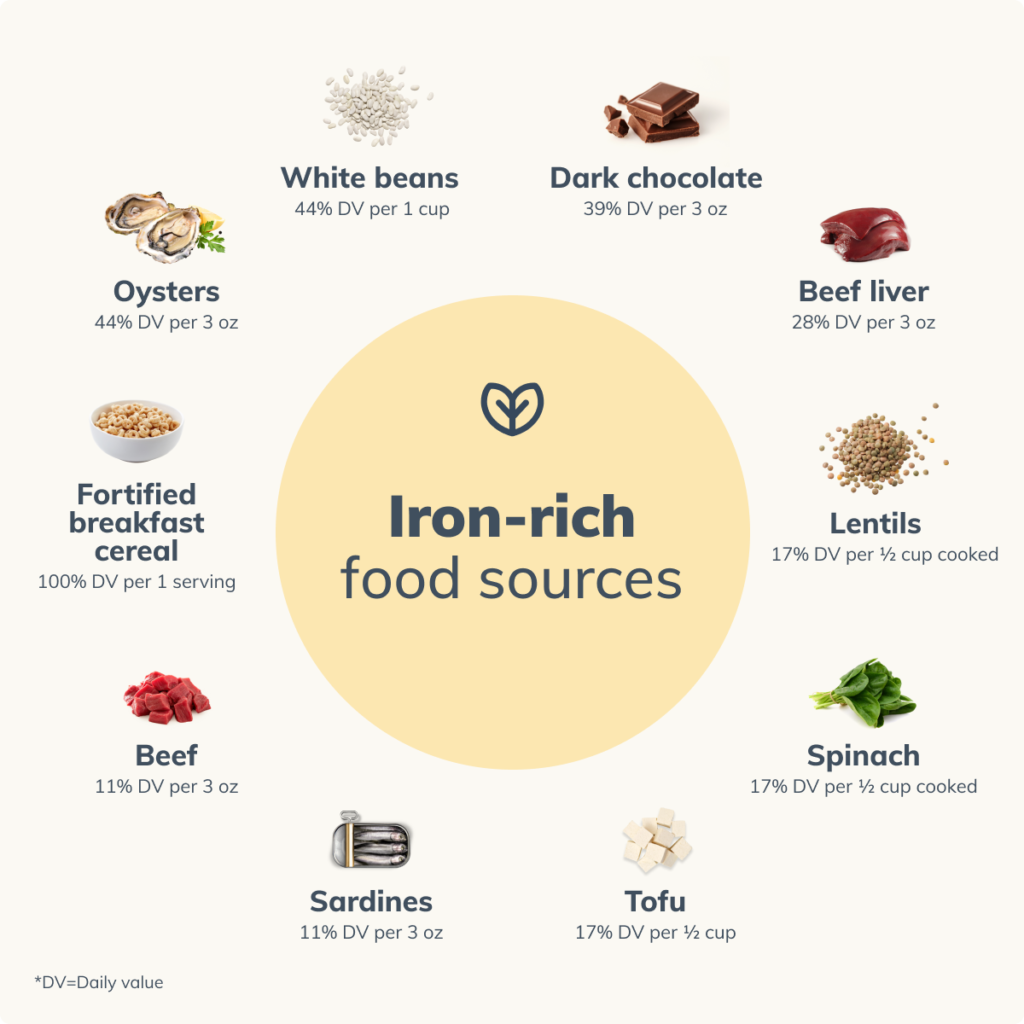
Like calcium, the amount of iron your child needs depends on their age and sex. The table below outlines the RDAs for iron.
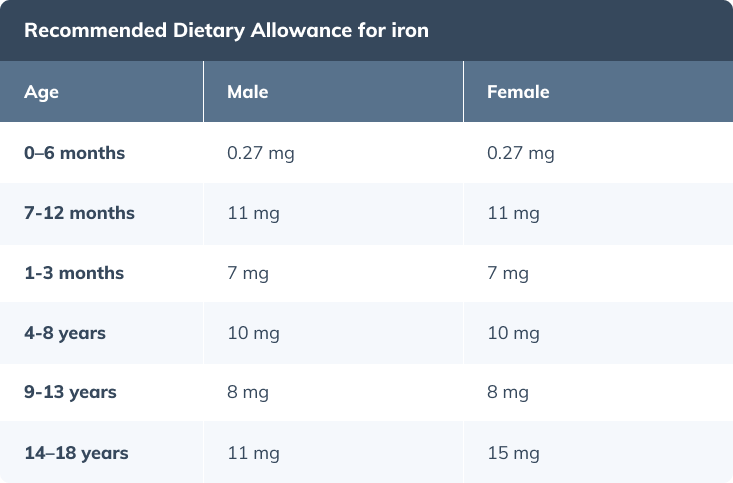
8. Water
Water may not be something that comes to mind when you think of nutrients; however, water is a nutrient critical to life at any age. (21) Every cell in your child’s body requires water in order to function. (15) Water is also needed for healthy bones as it acts as a lubricant protecting the joints. Additionally, water plays a role in digestion as it’s required for saliva production and the movement of food through the intestines. (15) Furthermore, it is also necessary for body temperature regulation, blood circulation, and brain development and function. (21)
The amount of water your child requires is dependent on their age and activity level. However, a good rule of thumb is that they consume one 8 oz glass per day for every year of age, and children over the age of eight should have at least eight 8 oz glasses or 2 L of water per day. The table below outlines the recommended daily intake for water. (1)

Tips to meet your child’s nutritional needs
This article does not include all the nutrients that the human body requires. The best way to ensure your child is getting all the nutrients they need is to encourage them to eat a variety of different foods from all food groups. Other tips to meet your child’s nutritional needs include:
- Make half of what is on your child’s plate fruits and vegetables.
- Choose healthy sources of protein, such as lean meat, nuts, and eggs.
- Serve whole grain breads and cereals instead of white or refined grains.
- Bake, grill, or steam foods instead of frying.
- Limit fast food and processed foods.
- Offer water or milk instead of sugary fruit drinks and sodas. (9)
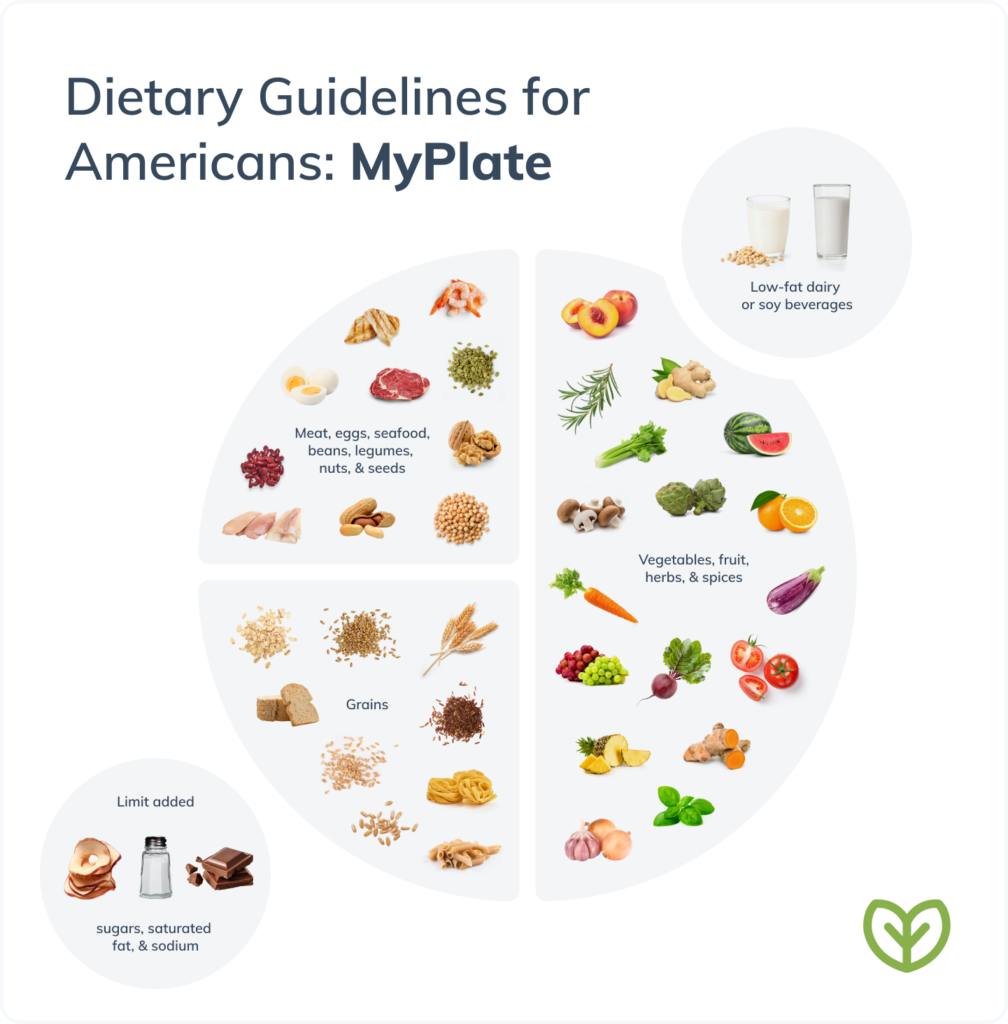
The bottom line
Childhood is a time of rapid growth and development. Meeting your child’s nutritional needs by feeding them a healthy diet will prevent health problems and promote a healthy growth and body weight, strong bones, brain development, and a strong immune system.
Ready to start delivering better patient care?

- CHOC – Children’s Health of Orange County. (2022, June 1). How Much Water Should Kids Drink? Children’s Health Orange County. Retrieved July 21, 2022, from https://www.choc.org/programs-services/urology/how-much-water-should-my-child-drink/
- Erdman, J. W., MacDonald, I., & Zeisel, S. H. (2012). Present knowledge in nutrition (10th ). International Life Sciences Institute.
- Faizan U, Rouster AS. Nutrition and Hydration Requirements In Children and Adults. . In: StatPearls . Treasure Island (FL): StatPearls Publishing; 2022 Jan-. Available from: https://www.ncbi.nlm.nih.gov/books/NBK562207/
- Gavin, M. L. (2021, January). Iron (for Parents) – Nemours KidsHealth. Kids Health. Retrieved July 21, 2022, from https://kidshealth.org/en/parents/iron.html#:%7E:text=Teen%20boys%20should%20get%2011,monthly%20when%20they%20begin%20menstruating
- Micronutrient Information Center. (2022, April 7). Phytochemicals. Linus Pauling Institute. Retrieved July 21, 2022, from https://lpi.oregonstate.edu/mic/dietary-factors/phytochemicals/
- Morris AL, Mohiuddin SS. Biochemistry, Nutrients. . In: StatPearls . Treasure Island (FL): StatPearls Publishing; 2022 Jan-. Available from: https://www.ncbi.nlm.nih.gov/books/NBK554545/
- Modern nutrition in health and disease: Eleventh edition. Wolters Kluwer Health Adis (ESP).
- National Institutes of Health. (2022, February 25). Healthy Eating As You Age: Know Your Food Groups. National Institute on Aging. Retrieved July 21, 2022, from https://www.nia.nih.gov/health/healthy-eating-you-age-know-your-food-groups
- National Library of Medicine. Child Nutrition. MedLine Plus. Retrieved July 21, 2022, from https://medlineplus.gov/childnutrition.html
- National Library of Medicine. Definitions of Health Terms: Minerals: MedlinePlus. MedlinePlus. Retrieved August 4, 2022, from https://medlineplus.gov/definitions/mineralsdefinitions.html#:%7E:text=Recommended%20Dietary%20Allowance%20(RDA)%20is,Health%2C%20Office%20of%20Dietary%20Supplements
- National Library of Medicine. Dietary Proteins. Medline Plus. Retrieved July 21, 2022, from https://medlineplus.gov/dietaryproteins.html
- National Library of Medicine. Iron. MedlinePlus. Retrieved July 21, 2022, from https://medlineplus.gov/iron.html
- National Library of Medicine. (2020, January 13). Hemoglobin. MedlinePlus. Retrieved July 21, 2022, from https://medlineplus.gov/ency/article/003645.htm
- National Library of Medicine. (2020b, July 13). Dietary fats explained. MedlinePlus. Retrieved July 21, 2022, from https://medlineplus.gov/ency/patientinstructions/000104.htm
- National Library of Medicine. (2021a, October 10). Water in diet. MedLine Plus. Retrieved July 21, 2022, from https://medlineplus.gov/ency/article/002471.htm
- National Library of Medicine. (2021b, November 3). Vitamins. MedlinePlus. Retrieved July 21, 2022, from https://medlineplus.gov/ency/article/002399.htm
- Office of Dietary Supplements. Office of Dietary Supplements – Calcium. National Institutes of Health. Retrieved July 21, 2022, from https://ods.od.nih.gov/factsheets/Calcium-HealthProfessional/#:%7E:text=Calcium%20deficiency%20can%20reduce%20bone,caused%20by%20vitamin%20D%20deficiency
- Office of Dietary Supplements. Office of Dietary Supplements – Iron. National Institutes of Health. Retrieved July 21, 2022, from https://ods.od.nih.gov/factsheets/Iron-Consumer/#:%7E:text=Iron%20is%20a%20mineral%20that,iron%20to%20make%20some%20hormones
- Office of Dietary Supplements. Office of Dietary Supplements – Iron. National Institutes of Health. Retrieved July 21, 2022, from https://ods.od.nih.gov/factsheets/Iron-HealthProfessional/
- Patel JK, Rouster AS. Infant Nutrition Requirements and Options. . In: StatPearls . Treasure Island (FL): StatPearls Publishing; 2022 Jan-. Available from: https://www.ncbi.nlm.nih.gov/books/NBK560758/
- Popkin, B. M., D’Anci, K. E., & Rosenberg, I. H. (2010a). Water, hydration, and health. Nutrition Reviews, 68(8), 439–458.
- Popkin, B. M., D’Anci, K. E., & Rosenberg, I. H. (2010b). Water, hydration, and health. Nutrition Reviews, 68(8), 439–458.
- Ross, A. C., Caballero, B. H., Cousins, R. J., Tucker, K. L., & Ziegler, T. R. (2012).
- Skolmowska, D., & Głąbska, D. (2019). Analysis of Heme and Non-Heme Iron Intake and Iron Dietary Sources in Adolescent Menstruating Females in a National Polish Sample. Nutrients, 11(5), 1049.
- Sugary Drinks and Childhood Obesity. (2009). Archives of Pediatrics & Adolescent Medicine, 163(4), 400. https://doi.org/10.1001/archpediatrics.2009.16
- USDA. (n.d.). What is MyPlate? | MyPlate. MyPlate. Retrieved August 4, 2022, from https://www.myplate.gov/eat-healthy/what-is-myplate





